What to Look for in a DET Creation Platform: Part 2 of 3

In Part 1 of this post, we discussed the advantages of collaborative learning in the workplace and the limitations of many current Digital Experiential Training (DET) platforms that only support single-player, asynchronous experiences. We highlighted Facilitate, a DET creation platform that allows for both asynchronous and synchronous content deployment, enhancing training effectiveness through collaboration.
Part 2: The Power of Collaborative Learning
Digital Experiential Training (DET) is a new way of thinking about today's digital learning, but for this type of content to be as valuable as it can be there are a few things to keep in mind.
The "Experiential" in the DET acronym means it's important to create as high a fidelity experience as is possible. This then shifts away from 'information overload' and mere presentation of facts, but allows the learner to connect with the material to a greater extent.
In order to achieve this however, the realism or fidelity of the experience should be high, so it feels like a close to real life experience for the learner. This is where content with multiple modalities is often best. Modalities in this context refers to either image based content (e.g. 360 VR) or the other main modality which is Computer Generated Imagery based content (e.g. CGI simulations). These two are the main modalities in immersive learning content today. Each of them have their pros and cons (e.g. 360 has the highest visual realism, whereas CGI allows for realistic object interactions).
If the aim is to create highly realistic learning experiences, it's easy to see that many training use cases will require both of these modalities. For example, image based content to show a piece of equipment or a site, or to convey the noise/space/activity level of a location; a 360 video is ideal here. Although photo realistic imagery can be created in CGI (like a modern Disney animation film), however, this level of CGI is clearly out of the realm of most organisations with more than one use case. Additionally, the learner also wants a realistic object interaction to learn a procedure, here 360 imagery won't work well at all and CGI content allowing interaction with 3D models is required.
So in order to create a realistic learning experience, content from both modalities is required. Many DET creation platforms will allow creation in either of these two modalities, but not both. Facilitate is unique in that it allows for both 3D models based content, we call these 'Microsimulations' as well as 360 based content. Moreover, these two modalities can be combined into one experience in a seamless manner, allowing for the creation of truly experiential training content. To learn more about this functionality or to try it for yourself, reach out to us for a free trial.
In Part 3, we will delve into the principle of empowering subject matter experts to create training content. This approach moves beyond the traditional L&D function, capturing expertise from across the organization with ease. We'll discuss how user-friendly tools like Facilitate can enable laypeople to contribute to the training creation process, ensuring that valuable knowledge is preserved and agility in addressing training needs is increased. Stay tuned to discover how this empowerment can significantly enhance your organization’s training initiatives.
